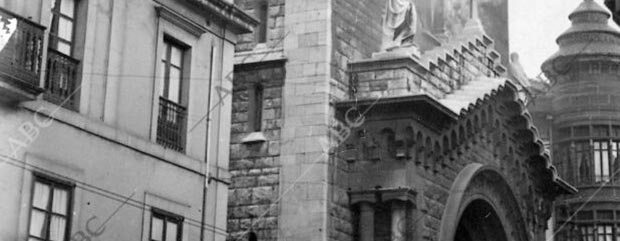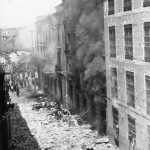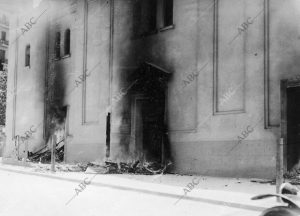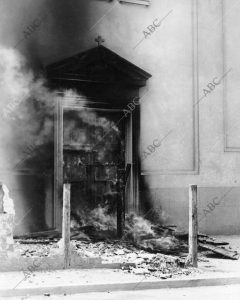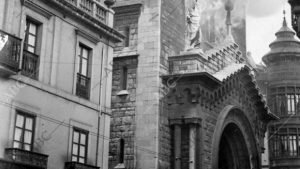Source:ABC
On 11 May 1931, a torrent of anti-clerical violence broke out in the capital, leading to the burning of convents. The government, on the ropes, was forced to bring the army into the streets despite initially dismissing the events as mere childishness.
May 11 1931 dawned bitterly in the capital after a black day of riots. The burning of churches and convents, no more and no less; a torrent of violence against the clergy at the dawn of the Second Republic. Everyone could sense the tension in the atmosphere. Or almost everyone… As Miguel Maura, then Minister of the Interior in the Provisional Government, explained in his memoirs, one of his colleagues saw no danger in the rioters taking to the streets with sticks and torches. The “quiet man” in question was Niceto Alcalá Zamora, acting president and more Cordovan than a salmorejo with its strips of ham.
– Calm down, Migué, this is nothing more than, as his father used to say, “bonfires of shavings”. It’s not as important as you think it is. It’s just a few kids playing at revolution and everything will calm down soon enough. You will see.
Maura, or so he wrote, reproached him for his stance. “You are foolish. Either you let me take my strength into the streets or all the convents in Madrid will burn, one after the other”. But the newly inaugurated Provisional Government was not about to charge the very people who had allowed the Republic to come into power. Manuel Azaña, an old acquaintance of those present, was clear about calling out the Guardia Civil: “Not that. All the convents in Madrid are not worth the life of a Republican”. The Minister of the Interior retreated indignantly to the office of another of his colleagues, Rafael Sánchez Guerra. The two despaired together.
The next few hours were chaos. “Every quarter of an hour came the news of another convent fire”. At the fourth “breaking news”, as Maura called it, he was asked to return to his colleagues. “The laughter and jokes were over. My colleagues were beginning to realise that they were faced with the beginnings of a riot started by a few youngsters, but that, given the absolute impunity they enjoyed, they could destroy much more than the convents“. When he arrived, the laughter was over and even the “quiet man” was on his guard: “Come here, Migué. You may be right”.
And he was right. In a few hours, an infinite number of religious buildings burned. Among them, the Jesuit house in Madrid. The situation only calmed down when the government ordered the army to enter the capital. By then, however, the arson madness had spread to other regions, such as Málaga, where forty buildings fell victim to the flames. All of them, of course, looted. But it was not the only one. Valencia, Alicante, Murcia, Granada, Cordoba, Jerez, Seville, Cadiz, Sanlúcar and Algeciras soon followed. In some places a state of war had to be declared and, in the end, four dead had to be counted. To cap it all, there were no reprisals.
Silenced
The madness began on Sunday 10 May, the day on which the Círculo Monárquico Independiente held, according to the ABC of the time, “the vote for the Board of Directors of the Central Committee”. During the event, a group of Republican hotheads clashed with the same number of royalists present. The fuse was lit, in the words of the newspaper Ahora, by a taxi that arrived in the area. “It was occupied by two individuals. They leaned out of the windows and shouted ‘Long live the King’ and ‘Long live the Monarchy’. The driver countered them with shouts of ‘Long live the Republic'”.
The madness spread and, within a few hours, a kiosk of the Catholic newspaper El Debate was burnt down. Several businesses considered “religious” were also targeted by the violence, and a demonstration took place in front of the headquarters of the General Directorate of Security. The situation looked murky.
Meanwhile, from 10 May onwards, ABC was unable to take to the streets. And that was after a group of hotheads had tried to burn down its headquarters. The Second Republic suspended publication of the newspaper and seized the Prensa Española (Spanish Press) building in Calle Serrano. The process (if it can be called that) lasted until 5 June, when the newspaper was able to report on the tragic events that took place during the so-called “burning of convents”. “In order to record in our collection the most important national events that took place during the period when ABC was forcibly cut off from its readers, we will now, in chronological order, summarise them”, the editor explained.
According to the journalist, they had been forced into silence “at the moment when it would have been opportune to formulate” the information. “Then we were unable to record the protest that we express today, ardent and painful, against the vandalism that marked the profanations and outrages committed in Madrid and in some provinces, on the occasion of the burning of churches and convents, outrages that have deserved the most energetic repudiation of every honest conscience”. The newspaper went on to list the major atrocities perpetrated in the capital.
Madrid burns
One of the most notorious attacks took place on 11 May against a more than popular enclave. “The residence of the Society of Jesus in Flor street was set on fire by mobs”, reported ABC. The news immediately reached the Council of Ministers, where it caused a mixed reaction among those present. Maura, in his memoirs, relates that he felt indignant because some of his colleagues made fun of what had happened. One of them found it hilarious that it was the sons of Saint Ignatius who were the first to “pay tribute to the sovereign people”. Azaña, for his part, wielded the famous “immanent justice”.
The journalist Josep Pla, who was present during the burning of the convent, said that “a dozen” hotheads did it all. “With some planks that were on Gran Vía, they knocked down a low window. Once inside the church, they made a pile of chairs and benches, which they sprayed with petrol, and set everything on fire with the straw”. In his words, he saw a vast flame rise behind the rose window of the building. “Outside, on the Gran Vía, the Guardia Civil on horseback, hand over hand, pass the time smoking,” he said. They had not yet received the order to arrest the inciters.
As ABC reported, it was then the turn of the “convent of Maravillas, in Bravo Murillo street; the Bernardas nuns, convent, in Isabel la Católica street; the Catholic Institute of Arts and Industries, in Alberto Aguilera street” and up to seven other religious buildings. Ministers were informed of all these fires and, as the hours went by, they realised that what they were dealing with was more than childishness. Indalecio Prieto himself, who was one of the most prominent figures in the Provisional Government, angrily entered the room on that fateful morning to give an account of what he had seen:
I have come from the Interior Ministry and I myself have spoken to Barcelona and Valencia. Nothing is happening anywhere and everything is calm. On the other hand, I have seen, in the Calle de Alcalá, the gangs of rogues who are burning convents with cans and scouring pads, and I say that it is a disgrace that they go about Madrid with impunity doing harm. This has to be stopped on the spot.
In Pla’s words, some of the people of Madrid took to the streets to revel in the flames. “The vendors do as they please. A line of citizens leaning against the wall took advantage of the time and had their shoes cleaned”. For them, it was a kind of gloomy festivity. “For many hours there was no better distraction in Madrid than the burning of convents. However, he also stressed that it would be a mistake to believe that everyone had seen the events in the same way. “Many citizens have watched it with long, sad faces. I don’t know if they are resigned. I would almost go so far as to say that the terrible blunder has not pleased the conscientious people in Madrid”.
Strange ending
From this point on there is some controversy about what happened. Maura maintains that, at about two o’clock in the afternoon, the Provisional Government met to decide whether or not to take the authorities out onto the streets. Azaña stood firm and voted no. And, as was to be expected, he was told that he would not. And, as expected, all his co-religionists followed suit. Largo Caballero spoke later, after the whole morning without saying a word, to point out that, although he was against violence, he was a socialist and could not repress the people. He abstained.
Once again, Maura decided to retire home in pain. Shortly before, however, he ran into a picket line demanding to speak to the ringleaders of the Second Republic. One of them was Pablo Rada, the man who had broken a world aviation record with Ramón Franco. It all came to nothing. It was not until five o’clock in the afternoon when, in view of the fact that it was impossible to maintain order and the public would not calm down, martial law was declared and the army was brought out onto the streets of the capital. According to the Provisional Government, in order not to involve the Guardia Civil in such an act of repression.
Share this article
On This Day
No Events
History of Spain
26 August 2020
27 January 2021
Communism: Now and Then
23 December 2022
28 July 2021
